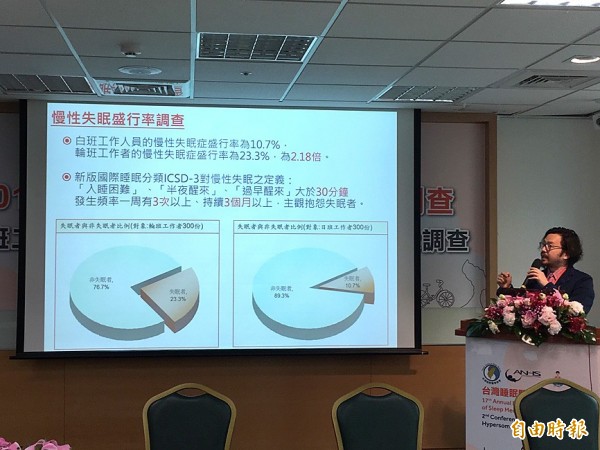《TAIPEI TIMES》 Shift workers more prone to insomnia, survey finds

Taiwan Society of Sleep Medicine public education commission head Wu Chia-shuo explains a graphic addressing chronic insomnia at the Chang Yung-Fa Foundation International Convention Center in Taipei yesterday. Photo: Lin Hui-chin, Taipei Times
By Lee I-chia / Staff Reporter
People who work in shifts are twice as likely to develop chronic insomnia than those who work regular hours, the Taiwan Society of Sleep Medicine said yesterday.
The society held its annual meeting in conjunction with the 2nd Conference of Asian Narcolepsy and Hypersomnolence Society at the Chang Yung-Fa Foundation’s International Convention Center in Taipei, where it published the results of a survey on the prevalence of sleep disorders in shift workers.
The survey found that shift workers, compared with people who work in daytime jobs, have a higher risk of developing physical and mental problems, including insomnia, cardiovascular disease, diabetes, mental illness and a weakened immune system, clinical psychologist and sleep medicine society public education commission head Wu Chia-shuo (吳家碩) said.
The survey of 300 shift workers and 300 daytime workers, showed that the prevalence of chronic insomnia was 23.3 percent in shift workers — 2.18 times that of the 10.7 percent found in daytime workers.
Chronic insomnia is defined as having sleeping disorders, including trouble falling asleep, waking up throughout the night and waking up too early, at least three times a week for three consecutive months, the association said.
“We also found that the more frequent they change shifts and the longer their shifts are, the more serious their insomnia becomes,” Wu said.
The survey found that the prevalence of chronic insomnia in workers who frequently switched between day and night shifts within a week was about 35.4 percent, professor of otolaryngology and society chairperson Li Hsueh-yu (李學禹) said.
The prevalence of chronic insomnia was about 30.6 percent in people who work more than 13 late-night shifts in a month, Li said.
The survey also found that the prevalence of illnesses were higher in shift workers than regular workers — 11.7 percent versus 3.7 percent for cardiovascular disease, 8 percent versus 4 percent for diabetes, 11.3 percent versus 3 percent for mental illness and 32.3 percent versus 12 percent for immune disorders over the past month.
The incidence rates of traffic or work accidents due to sleep disorders were also significantly different, with a 25.2 percent incidence rate for shift workers and a 2.7 percent incidence rate for regular workers, it said.
Managers should schedule longer work shifts, allowing employees to work in a shift for at least two weeks and letting them rest for at least two days when changing to a different shift, as the body’s physiological clock needs time to adjust, the society said.
新聞來源:TAIPEI TIMES
%http://www.taipeitimes.com/
















